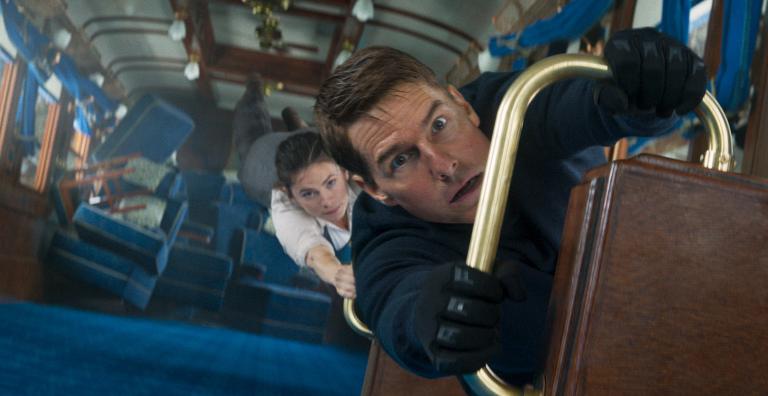
In the latest “Mission: Impossible” installment, neither Ethan Hunt – nor Tom Cruise – has any intention of playing by anyone else’s rules.
In “Mission: Impossible – Dead Reckoning Part 1,” Ethan and co. are up against a new kind of villain – an all-knowing, mysterious artificial intelligence known as The Entity. In the midst of a global race for control of the AI – a race that includes a mysterious man from Ethan’s past (Esai Morales) – Ethan’s right hand man Luther (Ving Rhames) tells him that if they want to win this fight, they need to start thinking like the enemy. They need to think like a machine – cold, logical, unemotional, unattached. But Ethan refuses, arguing their ties are the things that make them stronger, not the other way around.
This is the second film in a little over a year that can be read as a commentary on Cruise as one of the last of a brand of movie star that no longer exists. “Top Gun: Maverick” dares to ask if we still need Cruise, or if someone from the younger generation has the juice to take his place (the movie comes down firmly on the side of Cruise). But “Dead Reckoning Part 1” stands in a long line of “Mission: Impossible” films – particularly those of the Christopher McQuarrie persuasion – that take that narrative one step further. This installment casts Cruise as the man come to save the movies from themselves, and “Mission: Impossible” continues its run of excellent blockbuster entertainment. What continues to set the franchise apart is, of course, its commitment to practicality, but also its synergy with both Cruise’s place in the cinematic world and cinematic history more broadly.
There’s a way to read the plot of “Dead Reckoning Part 1” as a one-to-one comparison with the industry at large. Global superpowers (movie studios) attempt to control and monetize new technology, while Ethan Hunt/Tom Cruise (a relic of the old way) tries to put an end to the whole thing by doing increasingly wild stunts – in this case, driving a motorcycle off of a cliff before literally fighting on top of a train that was built specifically for the film. In this analogy, the studios are much like the AI itself – cold and unemotional, far more interested in profit over artistry. Cruise, while also most certainly interested in profit, casts himself as the opposition in the film and in his public persona. He will win this battle, not by thinking like his enemy, but by capitalizing on what he’s always done best.
In a world where IP runs the game, “Mission: Impossible” is one of the rare franchises where its star is not expendable. Superhero fare fills seats based on the character rather than the actor, but it’s near impossible to imagine how a “Mission: Impossible” film would work without Cruise. From the moment he steps out of the shadows to welcome a new IMF recruit, gravitas in his eyes and his jaw clenching with the weight of the wisdom he must impart, you have really no choice but to believe in this guy. Despite the film’s silliness – and there’s a good bit of silliness – that sense of importance permeates throughout the rest of the performances. Everyone is treated like a movie star in “Mission:Impossible.” From Rebecca Ferguson, to Simon Pegg, even to Henry Czerny – returning as IMF Director Eugene Kittridge for the first time since 1996 – the camera lends a weight to each actor that’s noticeably absent in so much franchise filmmaking.
The appreciation for stardom in “Dead Reckoning Part 1” extends to an appreciation not just for the franchise’s history, but for cinematic history at large. Throughout the film, but particularly when Kittridge enters the picture, there’s explicit homage to director Brian De Palma’s style from the first film. Dutch angles – the camera pointed upward, slightly canted askew – characterize the reunion between Ethan and Kittridge, zeroing closer in on Czerny’s and Cruise’s faces and becoming increasingly disorienting as the conversation rolls on. The stunts and action sequences in the film are staggering, yes. And yes, we all love knowing the extent to which the stunts were done practically. But the smaller moments of hand-to-hand combat – a sequence that’s split between Ethan caught in a claustrophobic tussle in a noir-drenched alleyway and another group in a graceful, almost balletic fight on a bridge is one of the film’s most nail-biting – and even the expository scenes are just as kinetic.
Cruise has been docked for his lack of chemistry with female co-stars in the past, and mostly for good reason. But the “Mission:Impossible” franchise, particularly the later films, eludes that issue by casting the chemistry between Cruise and various leading ladies in a tried and true cinematic frame. With Alanna Mitsopolis (an electrifying Vanessa Kirby), there’s a psychosexual noirish energy to their interactions, while Rebecca Ferguson’s Ilsa Faust is given the sweeping romantic storyline a la “Casablanca” (she’s named Isla for a reason). As Grace – a thief-turned-new-recruit – Hayley Atwell’s banter with Cruise feels airlifted right out of a Cary Grant and Katharine Hepburn film, and a sequence that finds the pair stuffed into a too-small Italian car on the run has a slapstick energy akin to a Buster Keaton film – right down to the way the two have to contort around each other to fit.
By paying homage to the past, “Dead Reckoning Part 1” feels fresher than ever. At the end of the day, I don’t really know whether Tom Cruise is the only thing that can save cinema. But when a franchise delivers this level of consistent excellence, it’s hard to argue with the premise.
